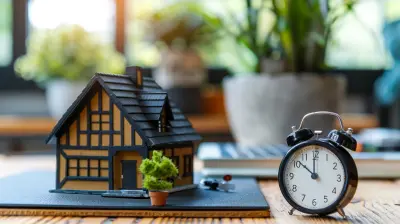How to Spot a Bubble in the Real Estate Market
5 August 2025
The real estate market can be a goldmine for investors, but what happens when home prices rise too fast—way beyond their actual value? That’s when you need to start worrying about a real estate bubble. If you're buying, selling, or investing in property, you must recognize the warning signs before the bubble bursts.
Let’s break it all down in simple terms—no jargon, just straight-up knowledge. 
What is a Real Estate Bubble?
A real estate bubble happens when property prices skyrocket due to high demand, speculation, and easy access to credit. But here's the catch—these prices aren’t supported by fundamentals like income growth or rental returns. Eventually, the bubble pops, bringing a sharp decline in prices, which can lead to financial losses for homeowners and investors.Think of it like blowing up a balloon. The more air (or in this case, hype and speculation) you pump into it, the bigger it gets—until it bursts. And nobody wants to be holding property when that happens! 
Key Signs of a Real Estate Bubble
So, how can you tell if the market is in bubble territory? Here are some major red flags:1. Rapid and Unjustified Price Increases
If home prices are rising way faster than salaries and rents, something’s off. Real estate values should grow steadily over time, not skyrocket overnight. When property prices shoot up dramatically within a short period, it's often fueled by speculation rather than real demand.A good rule of thumb? Compare home prices to income levels in your area. If homes are becoming increasingly unaffordable for the average buyer, the market could be bubbling.
2. Excessive Speculation
Ever heard people say, “Buy now, or you’ll never afford a home”? When there's a frenzy around real estate and people start flipping houses like it's easy money, that’s a bad sign.During a bubble, investors (and even regular buyers) start purchasing properties not because they need a home but because they believe prices will keep going up indefinitely. But here’s the reality: Nothing rises forever. When speculation drives the market instead of real demand, it’s only a matter of time before the bubble bursts.
3. Increase in Risky Loans and Easy Credit
When banks and lenders start offering mortgages with loose requirements (low down payments, no income verification, interest-only loans), it's a dangerous signal.Think back to the 2008 housing crash—it happened largely because lenders were handing out loans to people who couldn’t actually afford them. If mortgage lenders are approving loans left and right without checking whether borrowers can truly repay them, trouble is brewing.
4. Soaring Homeownership Rates
It’s great when people achieve homeownership, but if too many people are buying homes beyond their means, that’s a red flag.If mortgage debt is growing faster than the economy, it means people are stretching their finances thin just to buy a house. When the market corrects itself, many of these homeowners could find themselves underwater (owing more than their home is worth).
5. Declining Rental Yields
Investors buy properties to generate rental income. But if home prices are skyrocketing while rental income remains stagnant, that’s a problem.If you’re an investor, watch the rental yield—essentially, how much profit you make from renting a property compared to its price. When real estate prices outpace rental growth, it means properties are overvalued and unsustainable in the long run.
6. Economic Instability and Market Corrections
A healthy real estate market moves in cycles—ups and downs are normal. But if prices keep rising without correction, the market is in bubble territory.Look at the broader economy. Is job growth strong? Are wages keeping up with inflation? If the answer is no, yet home prices keep climbing, it's time to be cautious. 
How to Protect Yourself from a Real Estate Bubble
Now that you know how to spot a real estate bubble, what can you do to stay safe? Here are some smart moves:✅ Do Your Research
Don’t just jump into the market because “everyone else is doing it.” Analyze property prices, rental yields, and economic trends before making any decisions.✅ Avoid Overleveraging
Taking on too much debt to buy a house is risky, especially in a bubble. Always ensure you have a solid financial cushion in case things go south.✅ Think Long-Term, Not Short-Term
If you’re buying a home to live in for the next 10–15 years, short-term price fluctuations won’t affect you as much. However, if you’re looking for a quick flip, reconsider your strategy—bubbles don’t last forever.✅ Pay Attention to Interest Rates
Low-interest rates can fuel bubbles by making borrowing cheap. If rates start rising, housing affordability drops, and prices could fall. Keep an eye on what the Federal Reserve is doing with interest rates.✅ Analyze the Local Market
Not all real estate markets behave the same way. While prices may be overheating in one city, another might be perfectly stable. Compare local housing trends rather than relying on nationwide numbers.
Final Thoughts
A real estate bubble can be tempting—it feels like easy money when prices keep climbing. But history has shown us time and time again that what goes up must come down. If you’re thinking of buying or investing, take a step back and analyze the market carefully.Are prices rising too fast? Is speculation driving demand? Are people taking on dangerous amounts of debt? If so, it might be time to proceed with caution.
The key to real estate success isn’t following the crowd—it’s being smart, informed, and prepared for whatever the market throws your way.
all images in this post were generated using AI tools
Category:
Real Estate MarketAuthor:

Lydia Hodge
Discussion
rate this article
2 comments
Spike Meyers
Thank you for this insightful article! Your tips on identifying potential real estate bubbles are invaluable for both buyers and investors. I appreciate the clear and practical advice provided.
December 11, 2025 at 2:00 PM
Laila Patel
Great insights! Monitoring price-to-income ratios and interest rates can be crucial for identifying potential bubbles. Thanks for sharing these valuable tips with readers!
August 10, 2025 at 11:10 AM

Lydia Hodge
Thank you for your feedback! I'm glad you found the tips valuable. Monitoring those factors is indeed key to spotting bubbles!


